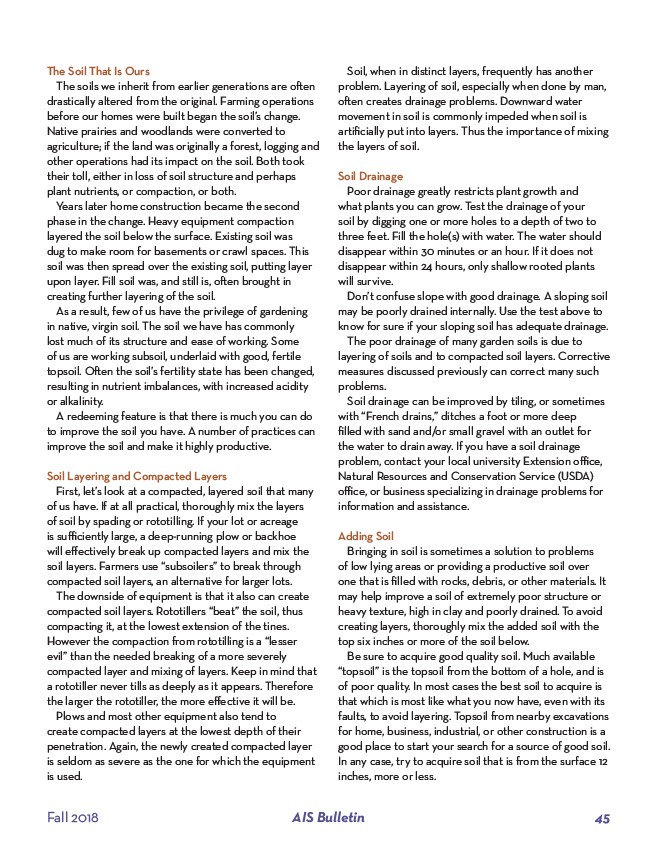
The Soil That Is Ours
The soils we inherit from earlier generations are often
drastically altered from the original. Farming operations
before our homes were built began the soil’s change.
Native prairies and woodlands were converted to
agriculture; if the land was originally a forest, logging and
other operations had its impact on the soil. Both took
their toll, either in loss of soil structure and perhaps
plant nutrients, or compaction, or both.
Years later home construction became the second
phase in the change. Heavy equipment compaction
layered the soil below the surface. Existing soil was
dug to make room for basements or crawl spaces. This
soil was then spread over the existing soil, putting layer
upon layer. Fill soil was, and still is, often brought in
creating further layering of the soil.
As a result, few of us have the privilege of gardening
in native, virgin soil. The soil we have has commonly
lost much of its structure and ease of working. Some
of us are working subsoil, underlaid with good, fertile
topsoil. Often the soil’s fertility state has been changed,
resulting in nutrient imbalances, with increased acidity
or alkalinity.
A redeeming feature is that there is much you can do
to improve the soil you have. A number of practices can
improve the soil and make it highly productive.
Soil Layering and Compacted Layers
First, let’s look at a compacted, layered soil that many
of us have. If at all practical, thoroughly mix the layers
of soil by spading or rototilling. If your lot or acreage
is sufficiently large, a deep-running plow or backhoe
will effectively break up compacted layers and mix the
soil layers. Farmers use “subsoilers” to break through
compacted soil layers, an alternative for larger lots.
The downside of equipment is that it also can create
compacted soil layers. Rototillers “beat” the soil, thus
compacting it, at the lowest extension of the tines.
However the compaction from rototilling is a “lesser
evil” than the needed breaking of a more severely
compacted layer and mixing of layers. Keep in mind that
a rototiller never tills as deeply as it appears. Therefore
the larger the rototiller, the more effective it will be.
Plows and most other equipment also tend to
create compacted layers at the lowest depth of their
penetration. Again, the newly created compacted layer
is seldom as severe as the one for which the equipment
is used.
Soil, when in distinct layers, frequently has another
problem. Layering of soil, especially when done by man,
often creates drainage problems. Downward water
movement in soil is commonly impeded when soil is
artificially put into layers. Thus the importance of mixing
the layers of soil.
Soil Drainage
Poor drainage greatly restricts plant growth and
what plants you can grow. Test the drainage of your
soil by digging one or more holes to a depth of two to
three feet. Fill the hole(s) with water. The water should
disappear within 30 minutes or an hour. If it does not
disappear within 24 hours, only shallow rooted plants
will survive.
Don’t confuse slope with good drainage. A sloping soil
may be poorly drained internally. Use the test above to
know for sure if your sloping soil has adequate drainage.
The poor drainage of many garden soils is due to
layering of soils and to compacted soil layers. Corrective
measures discussed previously can correct many such
problems.
Soil drainage can be improved by tiling, or sometimes
with “French drains,” ditches a foot or more deep
filled with sand and/or small gravel with an outlet for
the water to drain away. If you have a soil drainage
problem, contact your local university Extension office,
Natural Resources and Conservation Service (USDA)
office, or business specializing in drainage problems for
information and assistance.
Adding Soil
Bringing in soil is sometimes a solution to problems
of low lying areas or providing a productive soil over
one that is filled with rocks, debris, or other materials. It
may help improve a soil of extremely poor structure or
heavy texture, high in clay and poorly drained. To avoid
creating layers, thoroughly mix the added soil with the
top six inches or more of the soil below.
Be sure to acquire good quality soil. Much available
“topsoil” is the topsoil from the bottom of a hole, and is
of poor quality. In most cases the best soil to acquire is
that which is most like what you now have, even with its
faults, to avoid layering. Topsoil from nearby excavations
for home, business, industrial, or other construction is a
good place to start your search for a source of good soil.
In any case, try to acquire soil that is from the surface 12
inches, more or less.
Fall 2018 AIS Bulletin 45